Case Study Analysis: Ethical Dilemma of Un-tested System
VerifiedAdded on 2020/03/04
|7
|1574
|83
Case Study
AI Summary
This case study examines the ethical dilemma faced by a testing manager, Ken, who is pressured to approve the go-live of an un-tested system. The study delves into the facts, issues, and stakeholders affected by this decision, including the project team, end-users, and the client. It explores the ethical implications through the lenses of consequentialism, deontology, and virtue ethics, highlighting the potential for technical, security, and operational failures, as well as a decline in system quality and user satisfaction. The case analyzes the scenario in detail. The study presents the potential options available to Ken and recommends fighting the decision by presenting the ethical issues and potential consequences to the senior management. This involves preparing a presentation, organizing a meeting, and seeking assistance from other senior resources to ensure an ethical and professional resolution, ultimately meeting client expectations without compromising ethical standards.
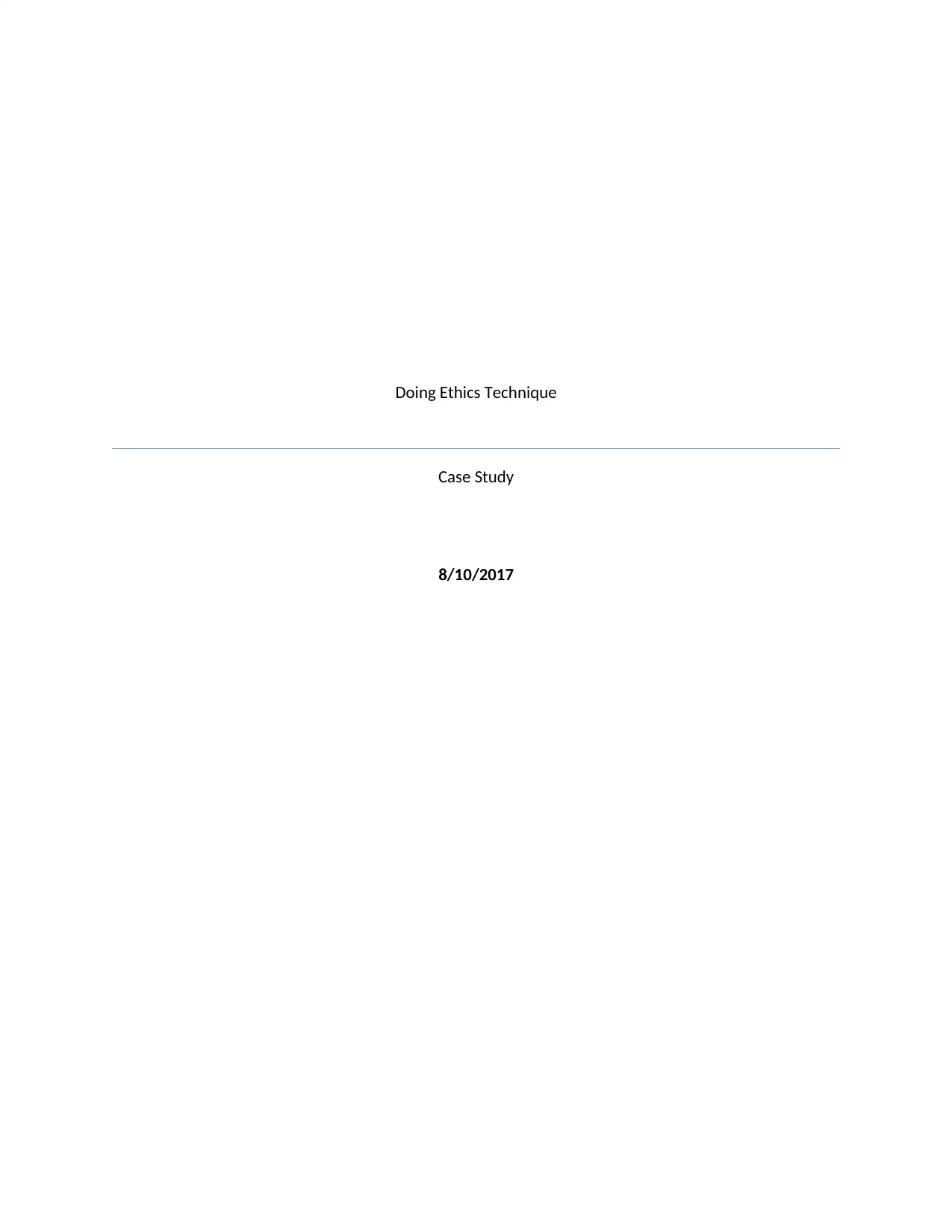
Doing Ethics Technique
Case Study
8/10/2017
Case Study
8/10/2017
Paraphrase This Document
Need a fresh take? Get an instant paraphrase of this document with our AI Paraphraser
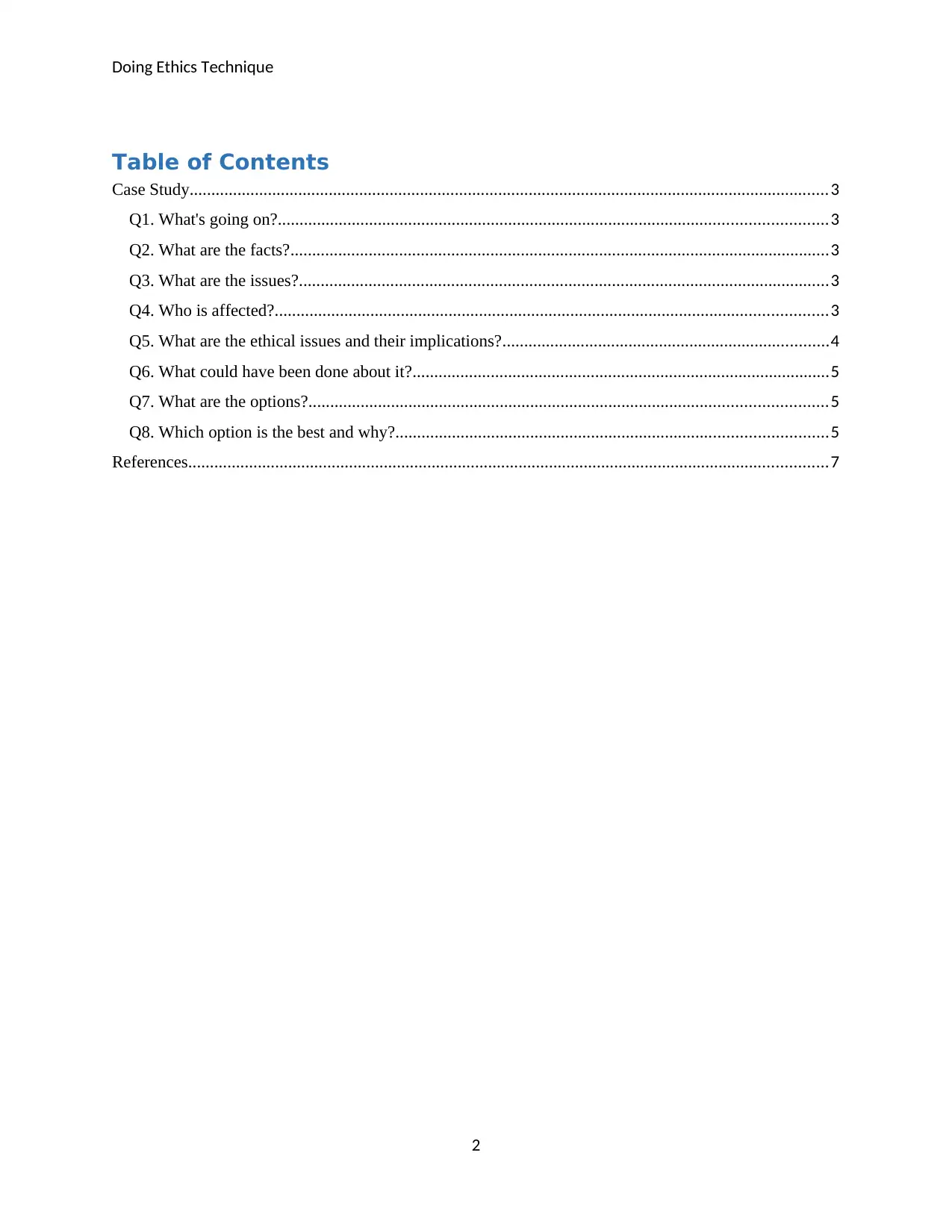
Doing Ethics Technique
Table of Contents
Case Study...................................................................................................................................................3
Q1. What's going on?..............................................................................................................................3
Q2. What are the facts?............................................................................................................................3
Q3. What are the issues?..........................................................................................................................3
Q4. Who is affected?...............................................................................................................................3
Q5. What are the ethical issues and their implications?...........................................................................4
Q6. What could have been done about it?................................................................................................5
Q7. What are the options?.......................................................................................................................5
Q8. Which option is the best and why?...................................................................................................5
References...................................................................................................................................................7
2
Table of Contents
Case Study...................................................................................................................................................3
Q1. What's going on?..............................................................................................................................3
Q2. What are the facts?............................................................................................................................3
Q3. What are the issues?..........................................................................................................................3
Q4. Who is affected?...............................................................................................................................3
Q5. What are the ethical issues and their implications?...........................................................................4
Q6. What could have been done about it?................................................................................................5
Q7. What are the options?.......................................................................................................................5
Q8. Which option is the best and why?...................................................................................................5
References...................................................................................................................................................7
2
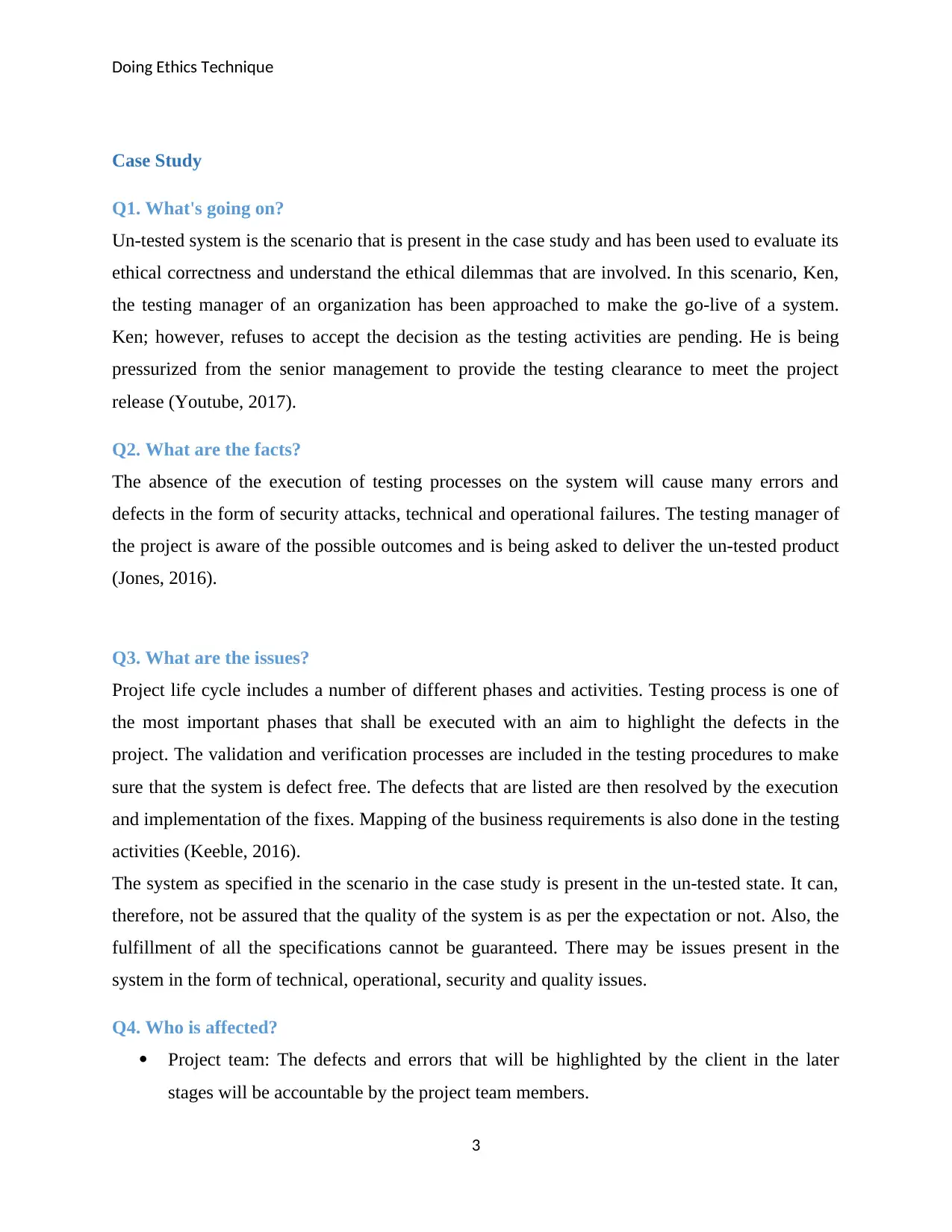
Doing Ethics Technique
Case Study
Q1. What's going on?
Un-tested system is the scenario that is present in the case study and has been used to evaluate its
ethical correctness and understand the ethical dilemmas that are involved. In this scenario, Ken,
the testing manager of an organization has been approached to make the go-live of a system.
Ken; however, refuses to accept the decision as the testing activities are pending. He is being
pressurized from the senior management to provide the testing clearance to meet the project
release (Youtube, 2017).
Q2. What are the facts?
The absence of the execution of testing processes on the system will cause many errors and
defects in the form of security attacks, technical and operational failures. The testing manager of
the project is aware of the possible outcomes and is being asked to deliver the un-tested product
(Jones, 2016).
Q3. What are the issues?
Project life cycle includes a number of different phases and activities. Testing process is one of
the most important phases that shall be executed with an aim to highlight the defects in the
project. The validation and verification processes are included in the testing procedures to make
sure that the system is defect free. The defects that are listed are then resolved by the execution
and implementation of the fixes. Mapping of the business requirements is also done in the testing
activities (Keeble, 2016).
The system as specified in the scenario in the case study is present in the un-tested state. It can,
therefore, not be assured that the quality of the system is as per the expectation or not. Also, the
fulfillment of all the specifications cannot be guaranteed. There may be issues present in the
system in the form of technical, operational, security and quality issues.
Q4. Who is affected?
Project team: The defects and errors that will be highlighted by the client in the later
stages will be accountable by the project team members.
3
Case Study
Q1. What's going on?
Un-tested system is the scenario that is present in the case study and has been used to evaluate its
ethical correctness and understand the ethical dilemmas that are involved. In this scenario, Ken,
the testing manager of an organization has been approached to make the go-live of a system.
Ken; however, refuses to accept the decision as the testing activities are pending. He is being
pressurized from the senior management to provide the testing clearance to meet the project
release (Youtube, 2017).
Q2. What are the facts?
The absence of the execution of testing processes on the system will cause many errors and
defects in the form of security attacks, technical and operational failures. The testing manager of
the project is aware of the possible outcomes and is being asked to deliver the un-tested product
(Jones, 2016).
Q3. What are the issues?
Project life cycle includes a number of different phases and activities. Testing process is one of
the most important phases that shall be executed with an aim to highlight the defects in the
project. The validation and verification processes are included in the testing procedures to make
sure that the system is defect free. The defects that are listed are then resolved by the execution
and implementation of the fixes. Mapping of the business requirements is also done in the testing
activities (Keeble, 2016).
The system as specified in the scenario in the case study is present in the un-tested state. It can,
therefore, not be assured that the quality of the system is as per the expectation or not. Also, the
fulfillment of all the specifications cannot be guaranteed. There may be issues present in the
system in the form of technical, operational, security and quality issues.
Q4. Who is affected?
Project team: The defects and errors that will be highlighted by the client in the later
stages will be accountable by the project team members.
3
⊘ This is a preview!⊘
Do you want full access?
Subscribe today to unlock all pages.

Trusted by 1+ million students worldwide
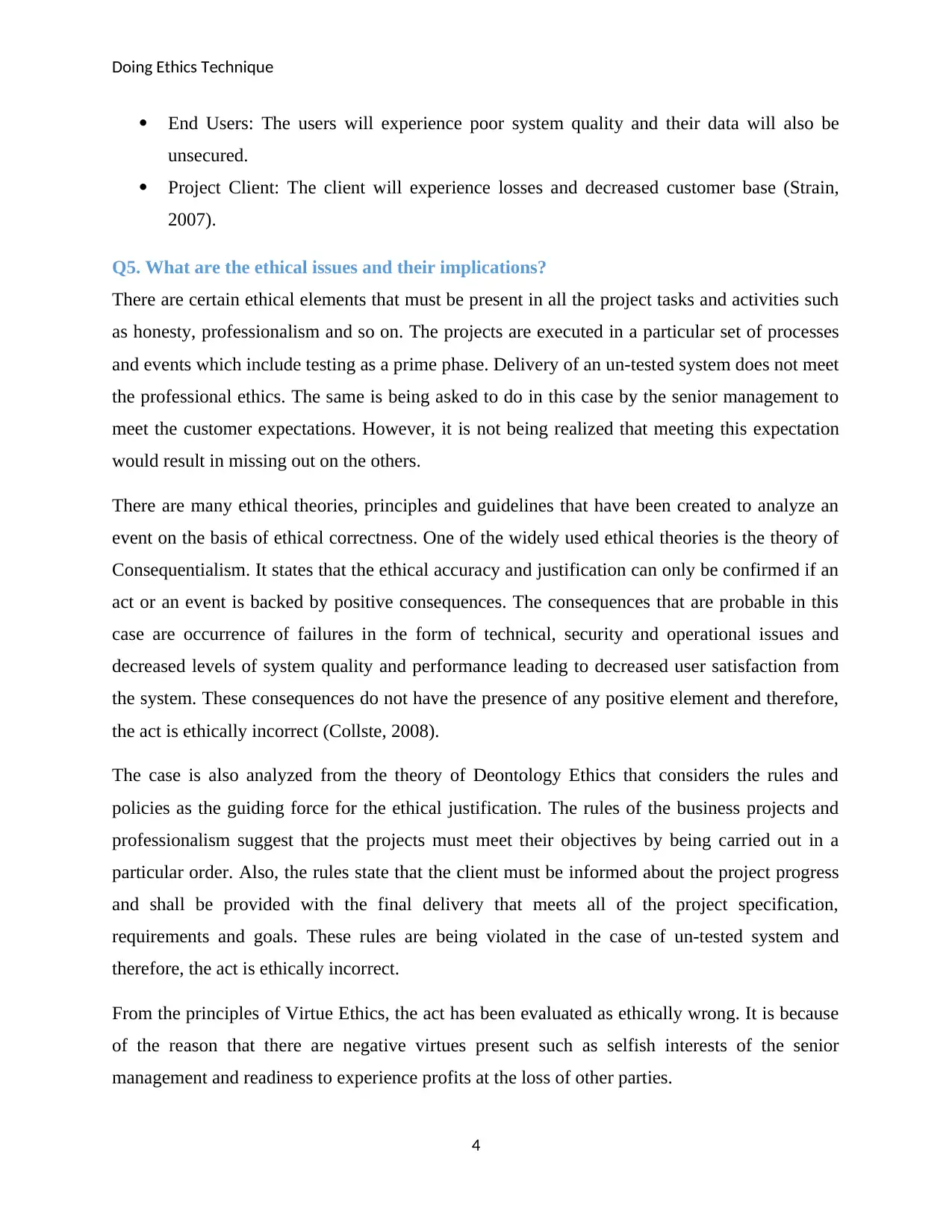
Doing Ethics Technique
End Users: The users will experience poor system quality and their data will also be
unsecured.
Project Client: The client will experience losses and decreased customer base (Strain,
2007).
Q5. What are the ethical issues and their implications?
There are certain ethical elements that must be present in all the project tasks and activities such
as honesty, professionalism and so on. The projects are executed in a particular set of processes
and events which include testing as a prime phase. Delivery of an un-tested system does not meet
the professional ethics. The same is being asked to do in this case by the senior management to
meet the customer expectations. However, it is not being realized that meeting this expectation
would result in missing out on the others.
There are many ethical theories, principles and guidelines that have been created to analyze an
event on the basis of ethical correctness. One of the widely used ethical theories is the theory of
Consequentialism. It states that the ethical accuracy and justification can only be confirmed if an
act or an event is backed by positive consequences. The consequences that are probable in this
case are occurrence of failures in the form of technical, security and operational issues and
decreased levels of system quality and performance leading to decreased user satisfaction from
the system. These consequences do not have the presence of any positive element and therefore,
the act is ethically incorrect (Collste, 2008).
The case is also analyzed from the theory of Deontology Ethics that considers the rules and
policies as the guiding force for the ethical justification. The rules of the business projects and
professionalism suggest that the projects must meet their objectives by being carried out in a
particular order. Also, the rules state that the client must be informed about the project progress
and shall be provided with the final delivery that meets all of the project specification,
requirements and goals. These rules are being violated in the case of un-tested system and
therefore, the act is ethically incorrect.
From the principles of Virtue Ethics, the act has been evaluated as ethically wrong. It is because
of the reason that there are negative virtues present such as selfish interests of the senior
management and readiness to experience profits at the loss of other parties.
4
End Users: The users will experience poor system quality and their data will also be
unsecured.
Project Client: The client will experience losses and decreased customer base (Strain,
2007).
Q5. What are the ethical issues and their implications?
There are certain ethical elements that must be present in all the project tasks and activities such
as honesty, professionalism and so on. The projects are executed in a particular set of processes
and events which include testing as a prime phase. Delivery of an un-tested system does not meet
the professional ethics. The same is being asked to do in this case by the senior management to
meet the customer expectations. However, it is not being realized that meeting this expectation
would result in missing out on the others.
There are many ethical theories, principles and guidelines that have been created to analyze an
event on the basis of ethical correctness. One of the widely used ethical theories is the theory of
Consequentialism. It states that the ethical accuracy and justification can only be confirmed if an
act or an event is backed by positive consequences. The consequences that are probable in this
case are occurrence of failures in the form of technical, security and operational issues and
decreased levels of system quality and performance leading to decreased user satisfaction from
the system. These consequences do not have the presence of any positive element and therefore,
the act is ethically incorrect (Collste, 2008).
The case is also analyzed from the theory of Deontology Ethics that considers the rules and
policies as the guiding force for the ethical justification. The rules of the business projects and
professionalism suggest that the projects must meet their objectives by being carried out in a
particular order. Also, the rules state that the client must be informed about the project progress
and shall be provided with the final delivery that meets all of the project specification,
requirements and goals. These rules are being violated in the case of un-tested system and
therefore, the act is ethically incorrect.
From the principles of Virtue Ethics, the act has been evaluated as ethically wrong. It is because
of the reason that there are negative virtues present such as selfish interests of the senior
management and readiness to experience profits at the loss of other parties.
4
Paraphrase This Document
Need a fresh take? Get an instant paraphrase of this document with our AI Paraphraser
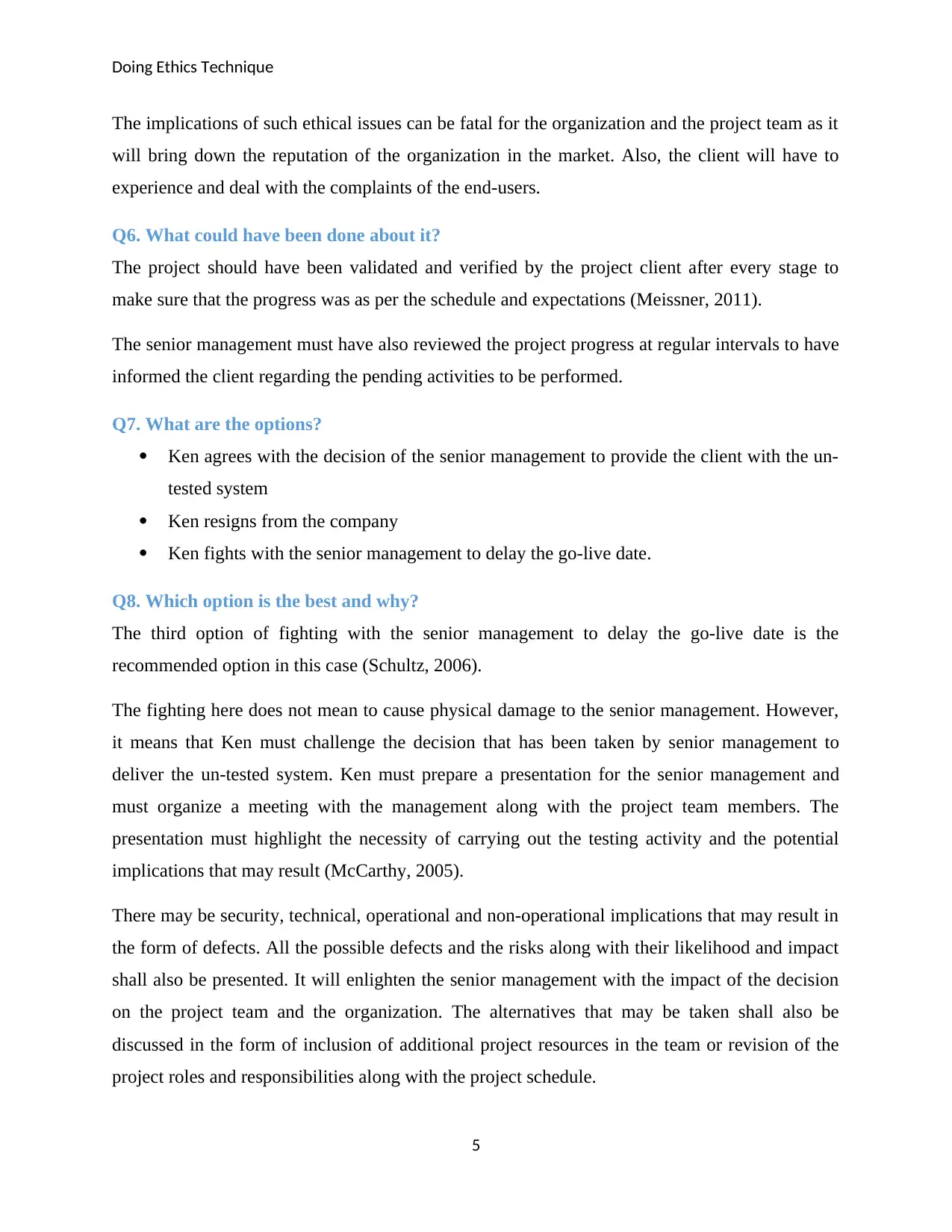
Doing Ethics Technique
The implications of such ethical issues can be fatal for the organization and the project team as it
will bring down the reputation of the organization in the market. Also, the client will have to
experience and deal with the complaints of the end-users.
Q6. What could have been done about it?
The project should have been validated and verified by the project client after every stage to
make sure that the progress was as per the schedule and expectations (Meissner, 2011).
The senior management must have also reviewed the project progress at regular intervals to have
informed the client regarding the pending activities to be performed.
Q7. What are the options?
Ken agrees with the decision of the senior management to provide the client with the un-
tested system
Ken resigns from the company
Ken fights with the senior management to delay the go-live date.
Q8. Which option is the best and why?
The third option of fighting with the senior management to delay the go-live date is the
recommended option in this case (Schultz, 2006).
The fighting here does not mean to cause physical damage to the senior management. However,
it means that Ken must challenge the decision that has been taken by senior management to
deliver the un-tested system. Ken must prepare a presentation for the senior management and
must organize a meeting with the management along with the project team members. The
presentation must highlight the necessity of carrying out the testing activity and the potential
implications that may result (McCarthy, 2005).
There may be security, technical, operational and non-operational implications that may result in
the form of defects. All the possible defects and the risks along with their likelihood and impact
shall also be presented. It will enlighten the senior management with the impact of the decision
on the project team and the organization. The alternatives that may be taken shall also be
discussed in the form of inclusion of additional project resources in the team or revision of the
project roles and responsibilities along with the project schedule.
5
The implications of such ethical issues can be fatal for the organization and the project team as it
will bring down the reputation of the organization in the market. Also, the client will have to
experience and deal with the complaints of the end-users.
Q6. What could have been done about it?
The project should have been validated and verified by the project client after every stage to
make sure that the progress was as per the schedule and expectations (Meissner, 2011).
The senior management must have also reviewed the project progress at regular intervals to have
informed the client regarding the pending activities to be performed.
Q7. What are the options?
Ken agrees with the decision of the senior management to provide the client with the un-
tested system
Ken resigns from the company
Ken fights with the senior management to delay the go-live date.
Q8. Which option is the best and why?
The third option of fighting with the senior management to delay the go-live date is the
recommended option in this case (Schultz, 2006).
The fighting here does not mean to cause physical damage to the senior management. However,
it means that Ken must challenge the decision that has been taken by senior management to
deliver the un-tested system. Ken must prepare a presentation for the senior management and
must organize a meeting with the management along with the project team members. The
presentation must highlight the necessity of carrying out the testing activity and the potential
implications that may result (McCarthy, 2005).
There may be security, technical, operational and non-operational implications that may result in
the form of defects. All the possible defects and the risks along with their likelihood and impact
shall also be presented. It will enlighten the senior management with the impact of the decision
on the project team and the organization. The alternatives that may be taken shall also be
discussed in the form of inclusion of additional project resources in the team or revision of the
project roles and responsibilities along with the project schedule.
5
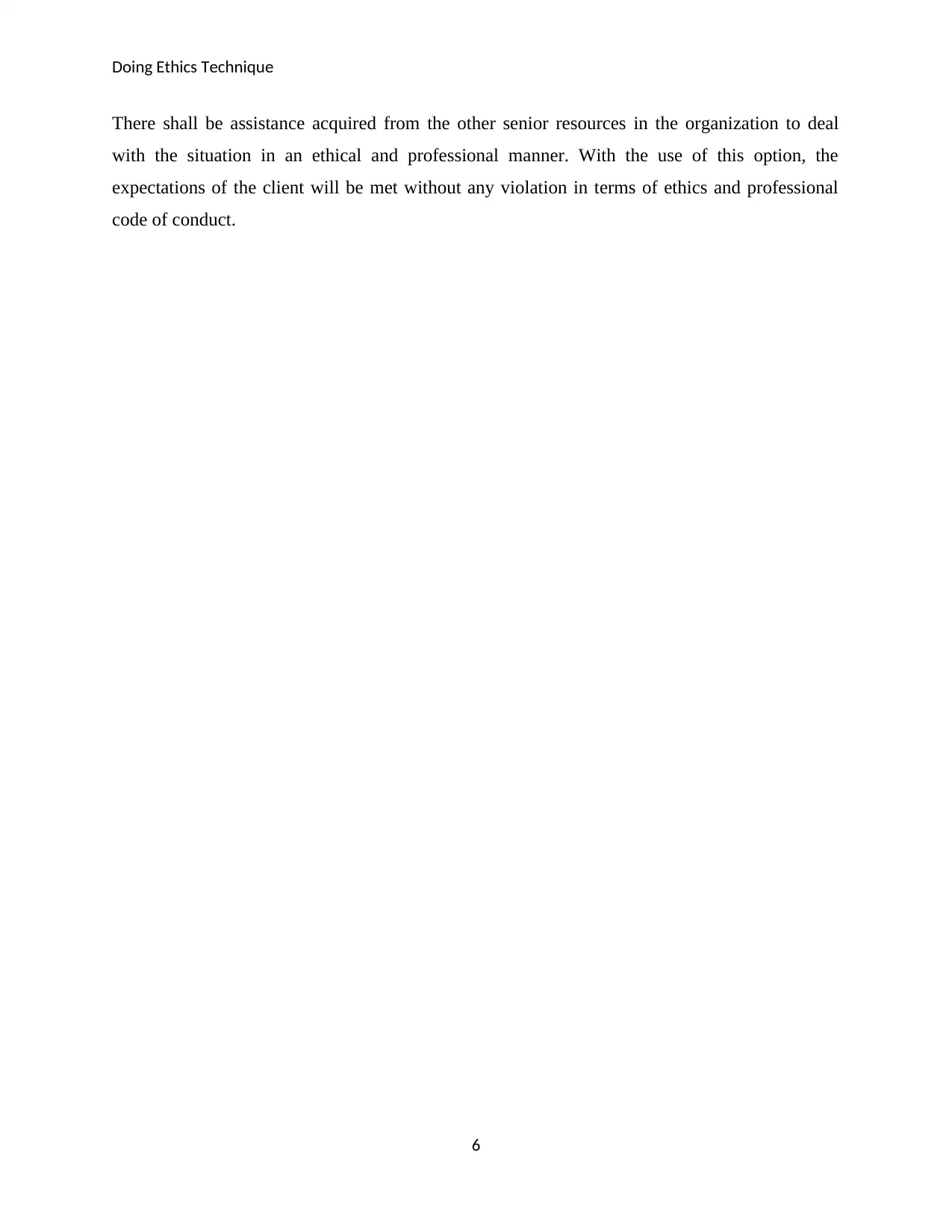
Doing Ethics Technique
There shall be assistance acquired from the other senior resources in the organization to deal
with the situation in an ethical and professional manner. With the use of this option, the
expectations of the client will be met without any violation in terms of ethics and professional
code of conduct.
6
There shall be assistance acquired from the other senior resources in the organization to deal
with the situation in an ethical and professional manner. With the use of this option, the
expectations of the client will be met without any violation in terms of ethics and professional
code of conduct.
6
⊘ This is a preview!⊘
Do you want full access?
Subscribe today to unlock all pages.

Trusted by 1+ million students worldwide
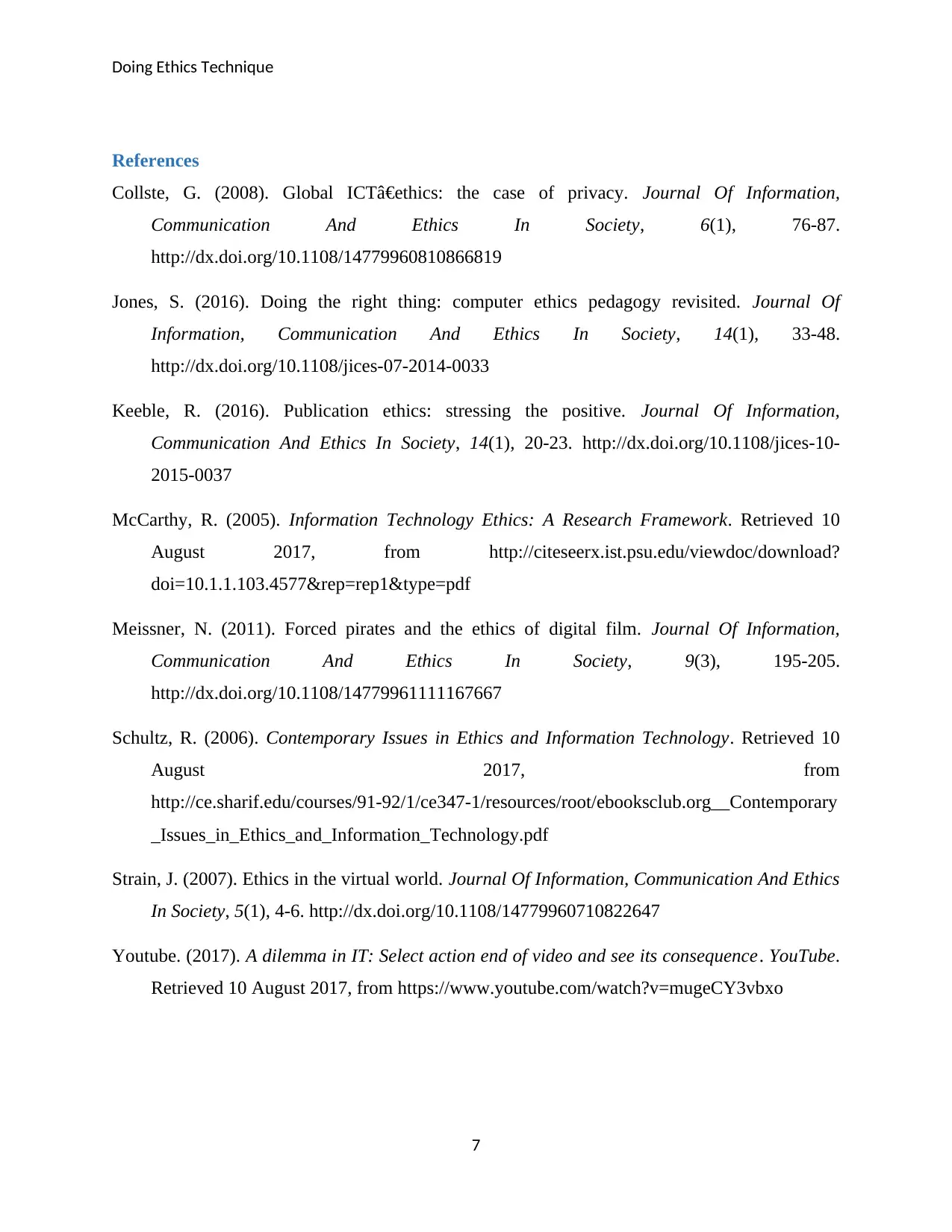
Doing Ethics Technique
References
Collste, G. (2008). Global ICTâ€ethics: the case of privacy. Journal Of Information,
Communication And Ethics In Society, 6(1), 76-87.
http://dx.doi.org/10.1108/14779960810866819
Jones, S. (2016). Doing the right thing: computer ethics pedagogy revisited. Journal Of
Information, Communication And Ethics In Society, 14(1), 33-48.
http://dx.doi.org/10.1108/jices-07-2014-0033
Keeble, R. (2016). Publication ethics: stressing the positive. Journal Of Information,
Communication And Ethics In Society, 14(1), 20-23. http://dx.doi.org/10.1108/jices-10-
2015-0037
McCarthy, R. (2005). Information Technology Ethics: A Research Framework. Retrieved 10
August 2017, from http://citeseerx.ist.psu.edu/viewdoc/download?
doi=10.1.1.103.4577&rep=rep1&type=pdf
Meissner, N. (2011). Forced pirates and the ethics of digital film. Journal Of Information,
Communication And Ethics In Society, 9(3), 195-205.
http://dx.doi.org/10.1108/14779961111167667
Schultz, R. (2006). Contemporary Issues in Ethics and Information Technology. Retrieved 10
August 2017, from
http://ce.sharif.edu/courses/91-92/1/ce347-1/resources/root/ebooksclub.org__Contemporary
_Issues_in_Ethics_and_Information_Technology.pdf
Strain, J. (2007). Ethics in the virtual world. Journal Of Information, Communication And Ethics
In Society, 5(1), 4-6. http://dx.doi.org/10.1108/14779960710822647
Youtube. (2017). A dilemma in IT: Select action end of video and see its consequence. YouTube.
Retrieved 10 August 2017, from https://www.youtube.com/watch?v=mugeCY3vbxo
7
References
Collste, G. (2008). Global ICTâ€ethics: the case of privacy. Journal Of Information,
Communication And Ethics In Society, 6(1), 76-87.
http://dx.doi.org/10.1108/14779960810866819
Jones, S. (2016). Doing the right thing: computer ethics pedagogy revisited. Journal Of
Information, Communication And Ethics In Society, 14(1), 33-48.
http://dx.doi.org/10.1108/jices-07-2014-0033
Keeble, R. (2016). Publication ethics: stressing the positive. Journal Of Information,
Communication And Ethics In Society, 14(1), 20-23. http://dx.doi.org/10.1108/jices-10-
2015-0037
McCarthy, R. (2005). Information Technology Ethics: A Research Framework. Retrieved 10
August 2017, from http://citeseerx.ist.psu.edu/viewdoc/download?
doi=10.1.1.103.4577&rep=rep1&type=pdf
Meissner, N. (2011). Forced pirates and the ethics of digital film. Journal Of Information,
Communication And Ethics In Society, 9(3), 195-205.
http://dx.doi.org/10.1108/14779961111167667
Schultz, R. (2006). Contemporary Issues in Ethics and Information Technology. Retrieved 10
August 2017, from
http://ce.sharif.edu/courses/91-92/1/ce347-1/resources/root/ebooksclub.org__Contemporary
_Issues_in_Ethics_and_Information_Technology.pdf
Strain, J. (2007). Ethics in the virtual world. Journal Of Information, Communication And Ethics
In Society, 5(1), 4-6. http://dx.doi.org/10.1108/14779960710822647
Youtube. (2017). A dilemma in IT: Select action end of video and see its consequence. YouTube.
Retrieved 10 August 2017, from https://www.youtube.com/watch?v=mugeCY3vbxo
7
1 out of 7
Related Documents
Your All-in-One AI-Powered Toolkit for Academic Success.
+13062052269
info@desklib.com
Available 24*7 on WhatsApp / Email
![[object Object]](/_next/static/media/star-bottom.7253800d.svg)
Unlock your academic potential
Copyright © 2020–2025 A2Z Services. All Rights Reserved. Developed and managed by ZUCOL.





